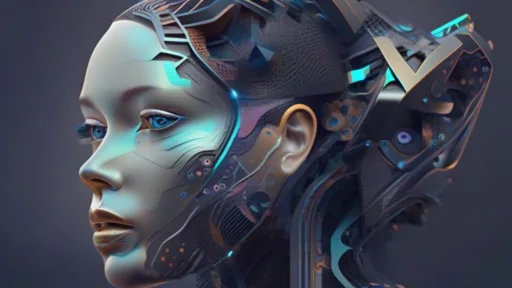Introduction
Generative AI, or generative fake insights, is a cutting-edge innovation that has picked up noteworthy consideration in 2023. It includes machine learning frameworks competent of creating different substance shapes, such as content, pictures, code, or other yields, frequently in reaction to client prompts. This article investigates the definition, workings, benefits, and dangers related with generative AI.
Generative AI definition
The term generative AI implies a bunch of approaches to the application of ML NN on enormous information sets with the point to find repetitive designs. From this learned data it at that point produces unused and at some point human-like yields. For illustration, a generative AI show planned for fiction composing can create unused stories comprising of comparable highlights such as plot settings, character, and themes.
How Does Generative AI Work?
However, Generative AI utilizes profound learning strategies, particularly fake neural systems propelled by the human brain. These models handle huge information sets to determine common designs and models in this way getting more astute as they are bolstered on more data. With the more substance, the generative ai demonstrate produces convincing and human-looking outputs.
The working of Generative Manufactured Insights (Generative AI) is based on perplexing components which utilize advanced profound learning and neural arrange calculations. Here is an in-depth see at how generative AI works:
- Information Collection and Training:
Datasets: This is how generative AI models begin off; they prepare on huge significant information sets that deliver them a see of the sort of substance they ought to create. For case, a text-based demonstrate can be created by utilizing gigantic sets of writings whereas a generator based on pictures can be made utilizing multitudinous picture sets.
Learning Designs: The demonstrate can distinguish such complex designs, structures and connections in the information amid the period of preparing. This is a strategy of looking out for similitudes, designs, and things that are prominent from the information provided.
- Neural Networks:
Architecture: The lion’s share of generative AIs are based on neural-like systems that mirror the working of a human brain. Transformer has been the most prevalent engineering and proceeds to perform well for errands such as NLP and picture creation.
Layers and Hubs: The neural systems include of a few interconnected hubs or neurons that offer assistance in preparing data and its change. The layers deliver the show a implies of speaking to data in an requested manner.
- Profound Learning:
Complex Computations: Profound learning is a specialization in machine learning in which a neural organize carries out dynamically advanced calculations upon the input information over progressive layers. This makes a difference the demonstrate to find and secure complex items.
Training Emphasess: This demonstrate goes through progressive preparing cycles which tune its internal parameters (weights and predispositions) after each cycle by comparing model-generated yield with the genuine data.
- Generative Process:
Prompt Input: Generative AI kicks off with giving provoke to a client who is teaching to donate out the starting data that leads to substance creation. Depending on the sort of bolster framework, this incite may constitute a content address, an introductory picture, or any other input that is applicable.
Pattern Acknowledgment: Generative AI works by abusing the watched designs in the preparing information and produces comes about cohering to the provided incite. For occurrence, if modified with content, it seem shape words and indeed sections but if modified with pictures, it would make images.
- Refinement with Client Feedback:
Iterative Advancement: Input can be conducted on an iterative premise for generative AI models. Clients can allow criticism on what is being created by this show hence permitting it to learn in arrange to make strides and deliver substance that suit users’ needs.
- Scaling with More Data:
Sophistication with Information Volume: Moved forward advancement of creating AI is made conceivable due to input of huge sets of crude information. With time, as the demonstrate gets and forms more information it gets to be exceedingly effective in creating similar and dissimilar products.
- Multimodal Capabilities (Optional):
Multimodal Models: A sub-category of generative AI models, named multimodal, are able to bargain with different modes of data counting, content, pictures, and audios. In doing so, they are able to deliver better and wealthier outputs.
- Deployment:
Integration into Applications: After preparing, a generative AI show can be presented into diverse apps like catbots, imaginative gadgets for composing, or coding partners giving people an opportunity to communicate with the AI and utilize its capabilities of producing content
Examples of Generative AI Models
Prominent illustrations of generative AI models include:
ChatGPT:This is an AI dialect demonstrate construct by OpenAI that answers to client request and yields normal text.
DALL-E 3:Dall-E is another OpenAI creation that makes pictures or depictions depending on the content composed down.
Google Minstrel: The generative AI chatbot of google competes with the Chat GTP, it answers questions and produces content based on the incite given.
GitHubCopilot: In developers’ environment, this is an manufactured intelligence-enabled coding device giving for insights and code completion.
Llama 2:Llama, an open source huge dialect show from Meta for building conversational ai models.
Generative AI works through Profound Learning, neural systems, and comprehensive preparing with pertinent datasets so that it can perceive designs and relationships in the information. In its era stage, the show takes in users’ inputs and makes yield by referencing the learnt designs some time recently upgrading itself with input and more data.
Types of Generative AI Models
There are a few bunches of generative AI models, such as transformer-based models, GANs, VAEs and multimodal models. There are a few sorts and each one is implied for a specific work, creating content, making pictures counting preparing of a few sorts of information at once.
Transformer-Based Models: They learn how to relate in a transient measurement data like words or sentences utilizing huge information sets. In NLP frameworks, they are great in comprehending the sentence structure and semantics of language.
Examples: ChatGPT-3, Google Bard.
Generative Antagonistic Systems (GANs): They are composed of two neural systems, i.e., a generator and a discriminator, working in pair but against one another. To begin with is a generator that makes reasonable information and moment is a discriminator which evaluates whether that information is genuine or not. This way, a arrangement of antagonistic forms surrender superior and superior craftsmanships over time.
Examples: DALL-E, Midjourney.
Variational Auto encoders (VAEs): Two systems, specifically, an encoder and a decoder are utilized in VAEs to change over and deliver the information. An encoder compresses the crude information into a compressed shape (less difficult), and the decoder reproduces compressed data into a few comparative but diverse from the to begin with one. Cases: They are broadly utilized in diverse pictures era applications.
Multimodal Models: Such models are able to control a few sorts of information at once counting writings, pictures and sound. They ended up competent of creating more complex and advanced comes about with this capacity. Illustrations: GPT-4 and DALL-E-2 are the creation of OpenAI.
Attention-Based Models: The consideration component makes a show to concentrate on certain fragments of input data whereas creating an yield. The prepare makes the demonstrate more able to see fine grain in the detail of the information and complex social information.Examples: A few advanced transformer models include consideration mechanism.
Recurrent Neural Systems (RNNs): They are built to handle arrangement input, which is done through a covered up state that takes into account information from earlier steps. They are not regularly utilized for generative AI but were basic in prior language-modellingexercises. Illustrations: As of late, most of the models do not utilize notable dialect models.
Autoregressive Models: In autoregressive models, progressive yields are delivered taking into account the going before components. This arranged or consecutive era handle underpins adaptable advancement of energetic, context-appropriate content.
Examples: PixelRNN, PixelCNN.
Large Dialect Models: The essential reason of these models is to capture human discourse and make it falsely. Transformer models are habitually connected whereas they can moreover be fine-tuned for diverse language-oriented issues.
Examples: GPT-3, ChatGPT.
Sparse Consideration Models: The computational overhead is decreased when meager consideration models go to to each component inside the input information. Since of their unequivocal quality they go to the required angles as it were and are more satisfactory in a few operations. Illustrations- A few meager consideration transformers for diverse sorts of transformer based models.
Generative AI models for different needs such as common dialect understanding, content era, picture union, and multi-modal substance creation. This demonstrate is subordinate upon the utilize case to which it will be put and the fabric of the substance it will generate.Each sort serves special purposes, from dialect assignments to picture blend, catering to assorted generative AI applications.
Benefits of Generative AI Amplify Over Industries:
Lower Work Costs: The mechanization of schedule errands comes about in less man-hours and subsequently decreases the costs for businesses.
Greater Operational Proficiency: Through the utilize of generative AI businesses can make forms productive and get freed of blunder, progressing execution in any operational elements.
Insights into Trade Forms: Besides, this innovation permits for the amassing and examination of gigantic volumes of data which give valuable data from a point of view of made strides working productivity. The utilize of a data-based approach empowers organizations to be more productive as they are able to discover what to alter in arrange to progress organizational effectiveness.
Empowering Experts and Substance Makers: Generative AI apparatuses give a plenty of benefits for experts and substance makers, helping in different angles of their work:
Idea Creation: As portion of the conceptualizing and ideation prepare, generative AI offers new points and concepts that may rouse innovation.
Content Arranging and Planning: Generative AI makes a difference experts to arrange when creating and plan substance for a uniform generation.
Search Motor Optimization (SEO): Optimizing such substance that is given by AI through SEO will offer assistance to increment perceivability on the web and the focused on traffic.
Marketing and Group of onlookers Engagement: Generative AI empowers advancement of customized and compelling fabric significant for superior promoting approaches and increased client involvement.
Research Help: Generative AI, for illustration, is advantageous in a inquire about errand where experts can effortlessly get basic information and direct them with their job.
Editing Back: With generative AI making a difference in the prepare of altering, it may offer suggestions with respect to enhancement, eventually encouraging the last step in substance refinement.
Time Reserve funds: The eminent advantage is that it takes a brief time in monotonous and time-consuming errands. These forms spare time, permitting proficient and manifestations to concentrate on assignments that require human intelligence.
The efficiency picks up are extraordinary but the manual supervision and examination over the generative AI models have to be tall. Generative AI ought to be utilized dependably by considering variables such as controlling predisposition and implementing morals which will offer assistance abuse its full capabilities inside different callings. The combination of human aptitudes and generative AI capabilities will revolutionize workflows as they are right now practiced by businesses and indeed drive predominant imagination and key outcomes.
Dangers and Restrictions of Generative AI
- Spread of Deception and Hurtful Content:
Concerns: Such publically accessible generative AI devices can lead to issues like deception, abhor discourse, and unsafe doctrines. In any case, it might be exceptionally perilous; from advancing bias to influencing person or career picture, indeed imperiling national security.
Policy Reaction: The year 2023 saw the European Union come up with copyrights controls that would require the companies to appear the copyrighted materials that have contributed intensely amid the creation of a generative AI tool.
- Workforce Displacement:
Concerns: A few concerns emerge from the reality that generative AI computerizes assignments, for occurrence, in workplaces, client benefit, or restaurants.
Impact: McKinney estimates almost twelve million word related shifts happening by year twenty-three hundred and thirty, with most of it being redundancies in particular areas.
- Administrative Response:
EU Enactment: In reaction, the European Union passed a proposition for modern enactment in early June this year that denies real-time confront location in open areas.
Is Generative AI the Future?
Industry Affect: Generative AI demonstrates a key portion for numerous divisions such as media generation and program building, which incorporate restorative issues among others, since it is creating fast.
Ethical Contemplations: Dangers are tended to by guaranteeing reasonableness, disposal of inclination, advancing straightforwardness, responsibility and information administration.
Innovation exceeds regulation.
Balancing Computerization: Generative AI must be controlled through a adjust of mechanization and human interest in arrange to capitalize on its focal points and maintain a strategic distance from its disadvantages.
Conclusion
The future for generative AI looks promising; be that as it may, it depends on the delicacy of the combination of development, ethics-governed and collaboration to meet the developing issues on the way ahead. The full potential of common fake insights can as it were be unleashed through capable integration and cautious controls as commerce, policymakers, and society navigates this modern landscape.





